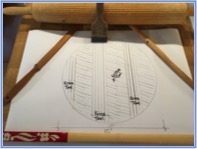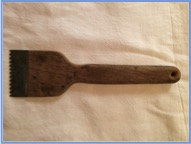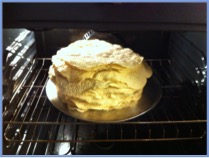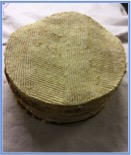Gary’s note: This is the final installment in Les Olsen’s three-part blog about krina lefse, a “very yummy” lefse, as Les puts it. The previous blogs (below) covered the tools for making the base krina-lefse round as well as the lore about krina lefse in Les’ family. This blog includes the topping recipe and a video on the fun application of the topping to the base round.
This is my family’s recipe for krina lefse topping:
2 eggs
1/2 cup cornstarch
1/4 cup sugar
3/4 cup milk
2 cups flour
Beat eggs until mixed. Add milk. Fold in cornstarch and sugar. Fold in 1-1/2 cups of flour. Then add just enough flour until when you pull a spoonful of topping out of the bowl, it will stretch and tear (see video). When the topping is thick and stringy, it will hold the pattern.
Take a round of krina lefse, place it on the countertop and place a large spoonful of topping on the lefse. With the spoon’s edge, spread the topping over the entire lefse round, all the way to the edges. If the edge is not covered, it will brown too fast.
Use the krina tool to scrape the excess topping off the lefse. Spread the topping in one direction, leaving only the ridges of topping.
Now use the krina tool to make the pattern in the topping. You can create your own pattern. We use my grandma’s pattern (see photo and video). I wonder how many pieces of lefse my grandma, mom, and I have finished with this pattern.

Place the lefse with topping on a baking sheet and put under the broiler. Set the broiler on low and the rack 6 inches below the broiling element. Here is the tricky part: Watch the lefse to make certain the topping turns only a light golden brown. This takes about 2 minutes under the broiler. Do not close the oven door. If you broil the topping too fast, it will bubble up off the lefse. Remove the round, and to keep it from curling, stack your rounds under flour sack towels and the heavy ¾-inch plywood (see video).
Final Preparations for Eating
You may wonder when you finally will get to eat krina lefse. Well, your stack of krina lefse will keep for months. After a few days the lefse will dry and harden.
When you are ready to eat krina lefse, run each round of lefse under warm water and place it between flour sack towels. DO NOT STACK. With a spray bottle, mist the lefse and towels every 5 to 10 minutes. The lefse will soften to an edible state in approximately 1 to 1-1/2 hours. At that point, butter the side without the topping, and apply cinnamon and sugar to taste. My cousins in Norway mix the butter, cinnamon, and sugar together and apply. Place the two pieces of prepared lefse together, topping sides out. Cut into wedges and serve.
Here is an alternative to cinnamon and sugar: In 1997 while in Norway, I visited a restaurant in Rognan where the heated krina lefse was served with melted brown cheese, sour cream, and butter. Very yummy!




